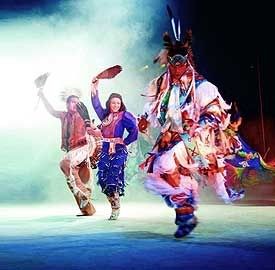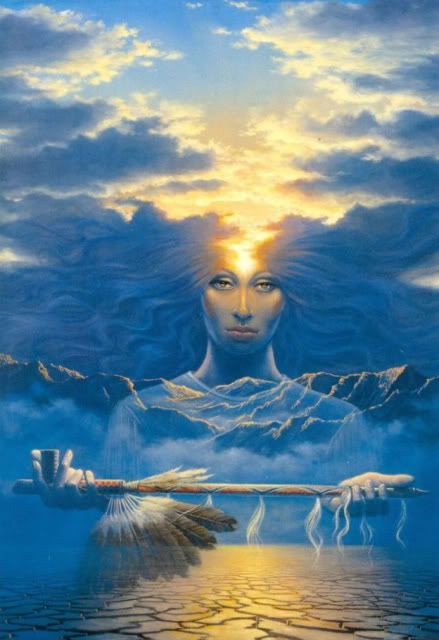
CaNte Ista. Those are the Lakota words used to describe a way of seeing that is good and true. When one has crawled out of the Initi, the sweat lodge, that is the way one may see. Within that small lodge, the red-hot stones have throbbed with heat, alive and vibrant as a heart-beat. The scent of sweetgrass and cedar have filled one's senses. The steam has risen as water was poured on the stones, and strong old songs of healing and thanks have risen as well. Cleansed of impurities of spirt and body by the four great powers of the world---earth, air, fire, and water---one may perceive things in a different way: CaNte Ista, through the Eye of the Heart.
The spiritual and symbolic place of the heart is as central to american Indian cultures as the physical heart is within the human body of a human being. When the heart is in the right place, when a person is in alignment with everything that is touched by the heartbeat, then there is true balance and peace. All things are equal and related to each other. That vision of the heart is a very democratic thing. I have heard it said, in fact that the heart of a good chief beats with the heart of the people. The heart of a chief is in the center of the circle of the nation. The good chief is like the heart in that he works for everyone, not just for himself.
The heart is literally the center and source of life. It is like the fire in the lodge that enables the people to survive the winter. When that fire goes out, we perish. The heart, California Indian people say, is fire. Without a heart, life cannot continue. Hunting has been of vital importance to every American Indian culture, and one of the oldest understandings among hunters is that a wound to the heart is invariably fatal. A good hunter knew the place of an animal's heart and how to aim an arrow or spear to strike that mortal spot. A common motif in american Indian art, especially among the people of the Great Plains, is an "x-ray" drawing of an animal with a line extending from its mouth to its heart. When the line of breath to the heart is cut, life ends. That is the natural way of things.
On the other hand, when the heart is unnatural--doubled like the hearts of Navajo skinwalkers or removed by sorcery from its normal location--then the balance is broken. When the heart is in the wrong place, chaos and evil enter the world. We see this in the Cattaraugus Seneca tale, "Turkey Boy Squeezed the Hearts of sorcerers." Related by George Jimerson in 1903 and published twenty years later by Arthur Parker in his landmark volume Seneca Myths and Folk Tales, it is a story filled with symbolic and direct references to the heart.
A boy named Turkey lives with his grandmother in a "lonely lodge a long ways from a settlement." One day, she shows him a hidden room full of clothing and weapons and many strange things, among them a great drum. She tells him these things belonged to his family. Now, however, all the people are gone. They have been devoured by a monster wizard who eats human flesh. His lodge is to the east in the midst of a bed of strawberries as large as human hearts. (The relationship of the shape of the strawberry to the heart is an interesting one that we see in other Native American traditions. In the Cherokee story of First Man and First Woman, first Woman leaves her husband because they quarrel. Grandmother Sun, the Great Apportioner, stops her by making the first strawberries--each shaped like a human heart--grow in her path. They are so sweet that First woman stops to pick some for her husband, allowing him to catch up to her and beg her pardon. So it is that the sharing of strawberries is associated with the love and understanding in our hearts.)
Turkey is fascinated by his grandmother's story. The next day, while she is away, he returns to the hidden room. He finds a lacrosse stick and ball and plays with them. Then he begins to beat the drum. He beats it so loudly that his grandmother returns, fearful that the sound will lead the monster wizard to them. "Tell me more about the monster," Turkey demands. His grandmother reveals that the cannibal wizard is named Deadoendjadasen and that he has seven sisters. "Make me a pair of moccasins," Turkey says. Then, wearing those moccasins, he sets out toward the east.
Upon reaching the monster's lodge, which is indeed surrounded by strawberries as large as hearts, Turkey sees a strange thing. A human skin tied to a cord is hung from a pole to keep watch on the lodge while Deadoendjadasen is away. To avoid being seen, Turkey shrinks down to the size of a mole and burrows over the pole. He convinces the skin Boy to tell him more about the monster, promising to set Skin Boy free. Skin Boy then tells him that the wizard and his seven sisters have all removed their hearts from their bodies so that they cannot be killed. (This is a common motif in American Indian traditions. Another notable example can be found in Chippewa Cree storyteller Ron Evans' wonderful telling of the story of Round Like a Ball Boy, in which the hero discovers that the hearts of the cannibal monsters are hung in a tree.) The eight hearts are hidden under the wing of a loon that swims in a little pool beneath the bed in Deadoendjadasen's lodge. Turkey obtains the hearts, and when the seven evil sisters and Deadoendjadasen try to catch him, he weakens them by squeezing on their hearts. Finally he kills them by hurling their hearts one by one onto a rock where they "each cracked open like a fint stone." He then freed Skin Boy---who becomes fully alive and human at his touch and turns out to be his lost brother--and brings back to life all of his people, whom the cannibal wizard had eaten.
As in many other cultures around the world, for most Native Americans the heart has been and remains associated with aspects of the emotion and cognition that modern science now attributes solely to the brain. Rather than seeing this as a lack of sophistication on the part of Native people, it might be remembered that despite all evidence to the contrary, the heart still holds its place as the symbol of love for the Western world. A heart made of stone is not just found in Iroquois stories. Moreover, there is a great deal of logic to the symbolism of the heart found in American Indian cultures.
Mohegan people say that the first lesson that we learn is from the heart. Harold Tantaquidgeon, a Mohegan elder, explained that to me many years ago while he was cutting wood outside the Mohegan Indian Museum in Uncasville, Connecticut. A child's first job is to listen, he said, his words punctuated by the rhythmic thud of the ax into the maple log. That was as far as he went with words. Like many things I've been taught by elders, the full meaning didn't hit me until many years later, when I thought back on that day and realized that the thumping regularity of each ax blow was much the same as the beat of a drum---or a heart.
The heartbeat is the first sound a child hears. Before that child draws breath, tastes food, or places her feet upon the earth, the child hears the heartbeat of her mother. In those many months before birth, the baby moves with the rhythm of the mother's heart and dances to the first song. Then, when a child has entered this world, seen the light, breathed the air, begun to walk, that child's feet are ready to dance when she hears the beating of a drum.
The place of the heart is also the place of the drum---remember the drum found by Turkey in the hidden room. This connection between the heart and the drum is often present in our languages. In Abenaki, the word for heart is pahko. To create the word for drum, we add the suffix ligan, which roughly means "to make something." Pahkoligan, the Abenaki word for drum, might then be translated as "that which makes a heart." This link between the drum and the heart is universal among Native Americans, though not every native language makes it quite so explicit. The mother's heart, the drum, and all of life are joined by a common understanding---frequently voiced at powwows, where the ceremonial fire and the drum are at the center of everything---that "the drum is the heartbeat of Mother Earth."
That is where the true place of the heart is---within that circle where all things are connected. The heart was meant to be part of that song whose rhythm is all of life.
(The Place of the Heart, by Joseph Bruchac)

{Programming by DPC}

